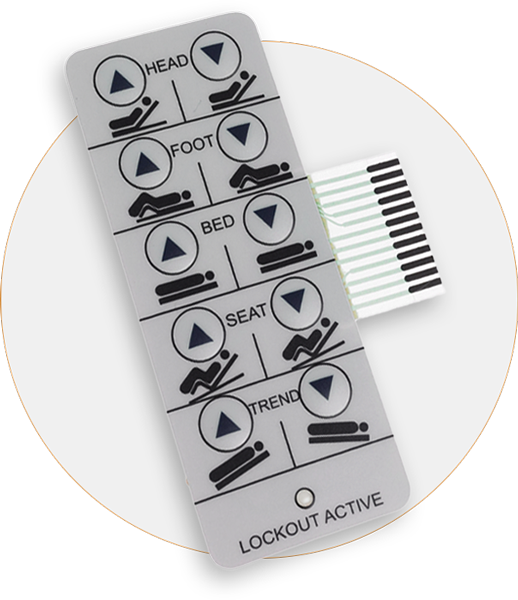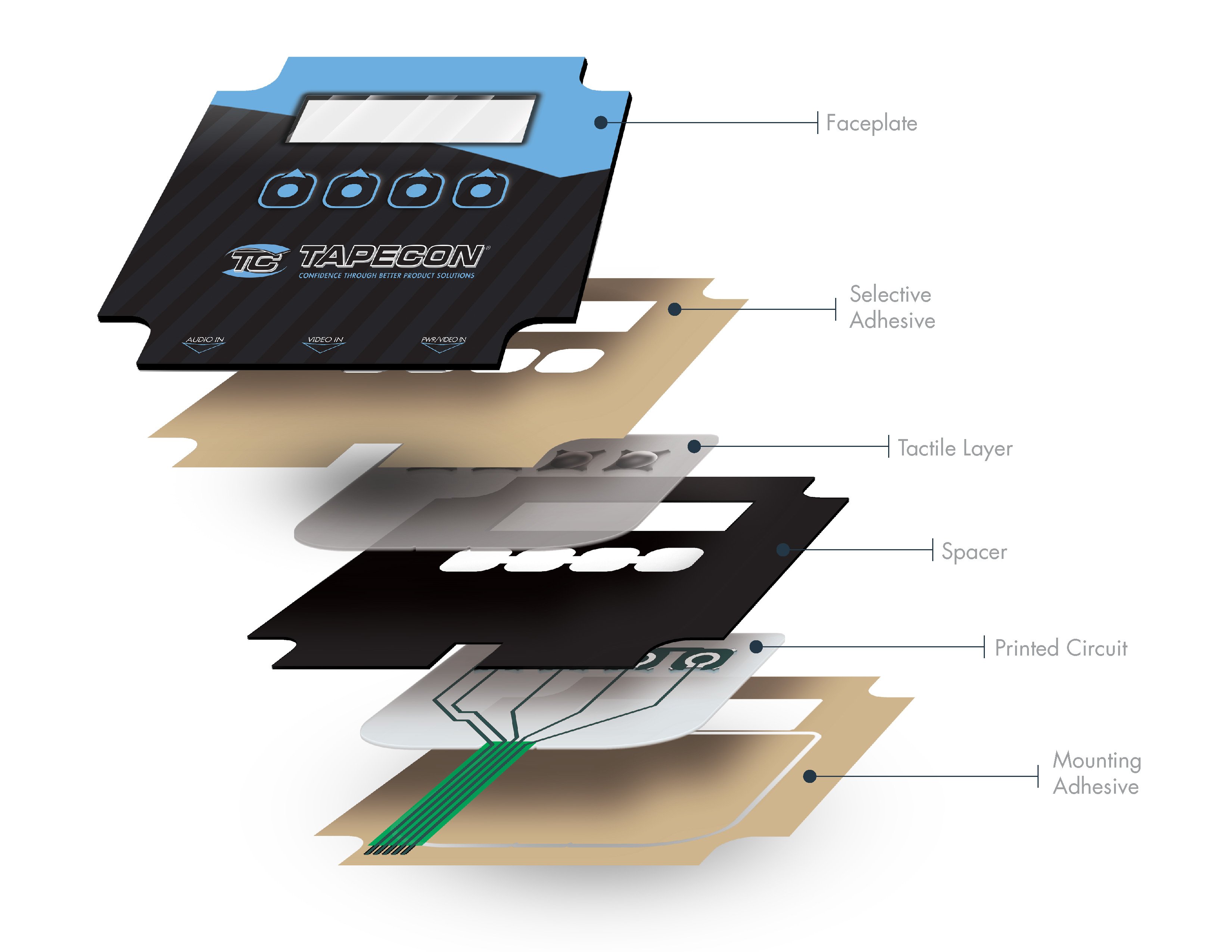Innovations in Membrane Switches for Touch-Sensitive Devices
Innovations in Membrane Switches for Touch-Sensitive Devices
Blog Article
Discover Exactly How Membrane Switches Function and Their Function in Modern Electronics
Membrane Switches represent an innovative combination of modern technology and layout within the world of modern electronic devices, offering as vital interfaces in many devices. Recognizing the complexities of Membrane button performance and their more comprehensive effects in improving user experience invites more expedition into their design, benefits, and the ingenious growths forming their future in modern technology.
What Are Membrane Buttons?

Membrane switches are differentiated by their resilience and resistance to ecological variables, such as dust, moisture, and extreme temperature levels. They can be personalized with numerous graphics, shades, and responsive comments options, improving user experience while maintaining aesthetic charm - membrane switches. Furthermore, the incorporation of published circuits permits seamless integration into devices, boosting overall performance.
The versatility of Membrane switches appears in their capacity to support both intricate and basic control features. They can integrate functions such as LED indicators and touch-sensitive technology, dealing with specific user requirements. As modern technology proceeds to develop, Membrane Switches continue to be necessary for allowing effective and intuitive customer interfaces, consequently playing a crucial function in the advancement of modern-day electronic gadgets.
Parts of Membrane Switches
Membrane switches are made up of numerous key elements that interact to develop a dependable and useful user interface. The main elements consist of the graphic overlay, sticky layer, spacer layer, and conductive traces.
The graphic overlay offers as the interface, commonly printed on an adaptable substratum such as polyester or polycarbonate. This layer not only supplies visual charm but also consists of tactile comments, aesthetic hints, and safety attributes. Beneath the graphic overlay exists the glue layer, which protects the button to the gadget and ensures durability against ecological stresses.
The spacer layer is important for maintaining the required void in between the graphic overlay and the circuit layer. When stress is applied, this space permits for the activation of the button. The conductive traces, usually made from silver or carbon, form the electric paths that complete the circuit when the switch is engaged.
Additionally, a support layer may be included for architectural assistance and insulation. These parts team up flawlessly, ensuring that Membrane switches are both user-friendly and resistant, making them indispensable in different contemporary digital applications.
How Membrane Switches Work
Just how do Membrane Switches function successfully within digital devices? Membrane Switches run on the principles of pressure-sensitive technology, utilizing a layered building and construction that consists of graphic overlays, glue layers, and conductive elements.
The style of Membrane buttons is vital for their efficient operation (membrane switches). The layers are carefully crafted to supply tactile responses, resilience, and resistance to environmental variables such as moisture and dirt. The addition of domes-- little, raised locations within the switch-- improves tactile feedback, supplying users with a recognizable click feeling upon activation
Moreover, Membrane switches can be tailored in terms of dimension, form, and graphics, making them suitable for various applications. They are usually used in control panels, clinical devices, and customer electronics because of their streamlined design and integrity. Generally, the reliable functioning of Membrane buttons is crucial in boosting user interaction and making certain seamless procedure in modern-day electronic gadgets.

Applications in Modern Gadgets
Using their one-of-a-kind design and functionality, Membrane switches have become important parts in a large range of contemporary digital gadgets. These functional interfaces are utilized in consumer electronics, industrial equipment, clinical gadgets, and vehicle controls, look here giving smooth customer communication.
In customer electronic devices, Membrane buttons are typically discovered in home appliances like microwaves, washing devices, and other household devices, where they enable intuitive control with a sleek profile. Their low-profile style assists go to these guys in combination into compact devices, improving aesthetic charm without endangering performance.
In industrial applications, Membrane Switches work as control board for equipment, offering resilience and resistance to harsh environments. Their ability to stand up to wetness and contaminants makes them perfect for usage in production and processing markets.
Medical tools additionally gain from Membrane switches, which are made to be simple to clean and keep, making certain hygiene in clinical setups. They are commonly made use of in diagnostic equipment, person tracking systems, and portable clinical tools, where dependability is vital.
Benefits of Membrane Switches
Among the key benefits of Membrane switches is their adaptability, which permits them to be customized for a variety of applications throughout multiple sectors. These switches can be made in different forms and sizes, accommodating special product demands while providing smooth assimilation into tools. Their thin account makes it possible for a streamlined and compact style, often enhancing the aesthetic allure of electronic products.
One more substantial benefit is their longevity - membrane switches. Membrane buttons are typically resistant to dirt, dampness, and chemicals, making them optimal for extreme atmospheres. This strength extends their life expectancy contrasted to traditional mechanical buttons, reducing the requirement for regular substitutes
Additionally, Membrane Switches offer cost-effectiveness. The production procedure involves printing modern technologies that reduce manufacturing prices, specifically for large runs. This cost, incorporated with reduced maintenance requirements, makes them an appealing alternative for producers.

Verdict
In verdict, Membrane Switches stand for a considerable advancement in user interface modern technology within modern-day electronics. As the need for resistant and user-friendly interfaces proceeds to grow, the function of Membrane switches in forming individual experience will certainly expand.
Membrane Switches represent an innovative combination of technology and style within the realm of modern-day electronics, read here offering as vital interfaces in numerous tools.In the realm of modern-day electronics, Membrane Switches serve as essential elements that promote customer interaction with tools. As innovation proceeds to progress, Membrane Switches remain crucial for allowing effective and intuitive individual interfaces, therefore playing a critical function in the development of modern electronic tools.
Exactly how do Membrane Switches function successfully within digital devices? Generally, the effective functioning of Membrane switches is crucial in enhancing user interaction and making sure smooth operation in contemporary electronic devices.
Report this page